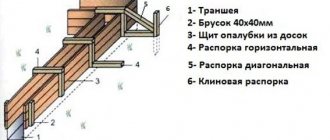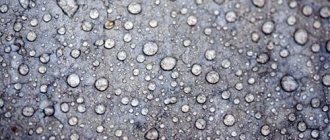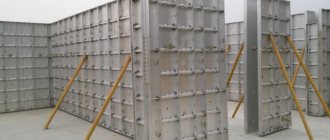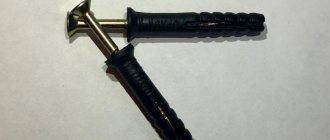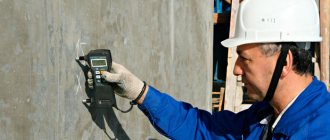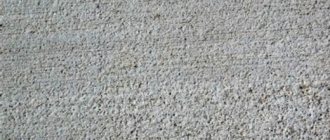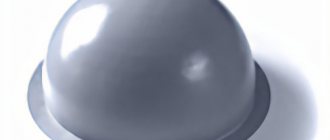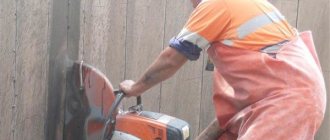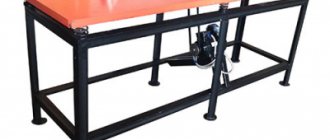Types of architectural concrete
The material used to create decorative elements of the facade or separate, independent compositions that serve to create the architectural and artistic appearance of the building or surrounding area is architectural concrete.
What distinguishes it from conventional building material is the presence of special additives that change the texture and make concrete more plastic and resistant to external influences. Concrete for decorative works has specific qualities:
Architectural concrete - application
- The fine-grained structure allows for smooth surfaces.
- The material has a low degree of hygroscopicity, so there are no carbonization processes in it that change the structure and strength.
- High resistance to atmospheric influences, in particular to ultraviolet radiation.
- Frost resistance, strength.
- The plasticity of the material allows you to use a variety of working techniques, allowing you to obtain products that are close in quality to sculptures or decorative elements made of natural stone.
The possibilities that characterize architectural concrete exist because of its composition. Fine crushed stone from marble or granite, plasticizers, coloring pigments, and other components can be used as filler. In this regard, the composition of architectural concrete does not have a fixed list of components and can be transformed during the process of preparing the mixture as required by the specifics of the work being performed. Such features of the material are highly appreciated by specialists in creating stucco moldings, various relief images and other decorations.
Types of flexible (elastic) concrete
Flexible concrete is a mixture of cement, water, aggregate and polymer fibers, which, when cured, produces an artificial material that can withstand bending stresses. In terms of strength characteristics, it is comparable to steel materials. The composite is several times higher than the flexibility of conventional cement structures [1]. This concrete has found application in earthquake-resistant construction, the manufacture of structures with complex architectural solutions, and the construction of bridges. The main countries producing ConFlexPave flexible concrete are Japan and the USA.
Self-healing elastic concrete is a durable polymer-cement concrete containing a preserved type of bacteria as an additive. When the structure is damaged, bacteria are activated by moisture. As a result of the interaction of water and atmospheric carbon dioxide with concrete, calcium carbonate is formed in cracks. Defects repaired in this way restore the integrity of the structure, and with further use, the healed areas have their original strength. The author of the invention is a scientist from the Netherlands – Henk Jonkers [2].
Due to its high cost, there is currently no mass production of this concrete. But the inventor continues research work to improve the characteristics of concrete and reduce the cost of its production.
Transparent concrete is a mixture of concrete with quartz fiber optic threads. This concrete has the effect of optical permeability. The threads in concrete give the material increased compressive and bending strength.
Unlike the previous two, transparent concrete is produced in Russia. Mainly used as a decorative finishing material for decorating walls, partitions, staircases, and countertops. Produced under the brands LintraCon, Illumicon.
Thanks to glass fiber reinforcement, the material has improved characteristics compared to conventional concrete. In addition to increased strength, water resistance and good soundproofing qualities, it is easy to manufacture. You can make this type of concrete yourself.
Advantages and disadvantages of architectural concrete
Architectural concrete has valuable advantages:
- High strength combined with ductility.
- Resistant to weather conditions and low temperatures.
- The presence of inorganic additives makes the material strong and durable, reduces wear, and protects against premature destruction.
- The cost of the products is low, which distinguishes them favorably from elements made from natural materials.
The disadvantages include:
- The material is heavy, and with a large amount of decor there is a serious additional load on the supporting structures. Because of this, the possibility of decorating light buildings with weak bearing capacity of supporting structures is excluded.
- Installing decorative components is a complex and labor-intensive task that requires the use of special equipment and skilled workers.
- The process of creating products requires a lot of time (several days).
- Creating jewelry requires high precision and high-quality fitting of elements. Small parts are difficult to work with, which reduces the capabilities of the material.
Correct proportions of architectural concrete mixture
The main elements that make up an architectural concrete mixture:
- Portland cement is light or white in color.
- Quartz sand.
- Dyes.
- Modifiers.
In addition to these components, you will need a filler that makes architectural concrete visually less homogeneous, adding resemblance to natural stone. Marble or granite chips and small crushed stone from other rocks are used. It is recommended to use a filler with a bright natural color, this will add realism to the appearance of the concrete. The ratios of the elements are different, there are a large number of options. Basically, different combinations of sand and filler shares are used.
An additional element is ground slaked lime, but it must be used with caution, since the presence of calcium negatively affects some building structures, and the processes constantly occurring in lime destabilize concrete.
Questions about technology Marble from concrete and plastic forms
Answers to your questions
What technologies are your molds suitable for?
Our forms are suitable for working with the following technologies:
- systrom
- Kevlar concrete
- ultra concrete
- granilite
- high strength concrete
- lasterobeton
- cast concrete
- selectively for dry pressing
What is the difference between the technologies Systrom, Kevlar concrete, Ultra concrete, Granilite, High-strength concrete and Lastero concrete? All technologies are used to produce concrete products that imitate the colors and textures of natural stone (marble, malachite, granite, onyx and others). Differences in names are a marketing ploy to attract customers.
How is a glossy surface achieved on products? The gloss on the surface of the products is obtained due to the forms (if the surface of the form is glossy, then the product will have a gloss, like on a polished natural stone, and if it is matte, then the product will have a matte surface) in the process of gaining strength of the concrete poured into the mold within 15 hours, subject to technology.
What production area does the production line occupy? The production itself, excluding warehouses and utility rooms, can be located on an area of 50 m2 (depending on the capacity of the plant).
What are the requirements for a production facility? Electricity of 10 kW must be supplied to the room and the room temperature must be maintained at 17-25°.
How many people operate the line? 3 workers are enough to produce 50 m2 of tiles per shift (1 work area).
What is the cost of producing tiles? The cost of materials and energy consumption for the production of 1 m2 of paving slabs 300*300*30 mm is 120 rubles. But before you start producing tiles or other products, you need to independently calculate the cost based on the initial data. You can download the Business Plan on our website.
Why do ABS molds purchased from other manufacturers crack and stick? Many mold manufacturers claim that they make their own ABS sheets and pellets. It is not true. Only 3 factories are capable of producing ABS sheets in the territory of the former Soviet Union. Our company orders special heat-resistant plastic, which contains imported rubber-based granules from a German manufacturer. Due to this, the product becomes glossy and adhesion improves.
The technology package costs you 50,000 rubles. What will I get for this money? You are trained in two technologies for producing artificial marble from concrete. The technology package includes: 1. Information on paper and electronic media (detailed description of the technological process, Calculation formulas for raw materials and their detailed descriptions, 35 initial color solutions, List of the largest suppliers of raw materials for production, Technology for laying paving slabs and facade stones, Photo catalog of good quality of finished products, Many finished objects with assembled products from high-strength concrete, etc.). 2. Training of your staff (no more than three people) at our production base. The training lasts 2-3 working days or until it is enough for you. 3. Further support and assistance in solving your production issues related to the production of heavy-duty concrete. If possible, assistance in finding raw materials. 4. We will transfer to you all further improvements developed by us in the field of high-strength concrete free of charge. Mold production technology is not included in the technology package. Only production of high-strength concrete products
What are the differences between the two technologies? The first method of pellet formation is carried out on a gravity concrete mixer (pear-shaped) for the production of paving slabs, facing stones, fences, fireplaces, etc. Mixing is done with both white and gray cement (500 D0). You can use washed river or quarry sand (without loam). Granite screening fraction 5-10 mm is added. The second technology for the production of artificial marble, granite, onyx, malachite (for interior decoration, decorative items) on a forced concrete mixer, using the mushy method (powdering, selection). It is a completely different method of preparing a concrete mixture and the indescribable beauty of color solutions is close to natural stones. White cement 500 D0, washed river sand, concrete pigments and plasticizer are used. The technologist teaches both methods. In the process of work, preference is given to one or another method. Products using both technologies have the same physical and mechanical properties.
Why do you insist on purchasing a vibrating table made by you? There are many other offers on vibrating tables on the market. The vibrating table that we (our organization) offer is slightly different from other similar mechanisms. It has exactly the amplitude of vibration that is necessary to obtain a given density of concrete, and also has horizontal vibration, which allows us to achieve complex patterns of marble and malachite. The table has a fairly large working surface (2.1 m by 0.7 m), which allows us to achieve a productivity of 50 to 70 m2 of finished products in an 8-hour shift. Please note that the price is minimal. In addition, by purchasing a vibration table from us, you can subsequently assemble a copy in its image in your region. We can provide drawings of the vibrating table for free, but the engine and vibration unit cost 11,000 rubles.
Do you need a molding table? When producing paving stones with a thickness of more than 60mm, it is necessary to use a forming table with vertical vibration.
Do the products really look as shiny as in the photo? The photographs presented on the site have not been processed in photo editors. Both gloss and matte finish on products is achieved exclusively through our shapes.
I became very interested in this production and began to collect information on the Internet, but I discovered that for some reason there were other companies in Nizhny with the same product range. We guarantee our forms for 1 year. Practice shows that if taken care of, molds last 2 or even 3 years! Other organizations are given a guarantee in the words “UP TO HUNDRED FILLS.” In fact, their uniforms cost a maximum of 20 and are more expensive than ours. Also, some organizations suggest the use of so-called matrices. The cost of one is 300 euros. Our forms don't require any of this. Our company’s office is located in the same building as the product warehouse and training area, so you can see everything with your own eyes and at once. When looking for a reliable partner, be vigilant and try to study the market in detail.
Do you have all the forms presented on the site in stock? If there are none, what is the lead time for their production? We have a fairly large assortment of types of forms (more than 300 items), plus the surface of each form can be either glossy or matte. The company has large warehouse facilities, so the most popular forms are in stock, the rest of the catalog items are made to order within 3 working days. In the spring-summer season, the timing increases.
Our company also offers custom-made plastic molds according to your drawings and sketches. To calculate the cost of molds for an individual order, you must provide a drawing, sketches indicating the exact dimensions and the planned number of molds to order.
I produce paving slabs using conventional technology, using Polish molds. Will your molds suit me? Yes, sure. You can use our molds for other vibration casting technologies. As practice has shown, they are excellent and free you from such additional actions as steaming, unmolding on a vibrating table, lubrication, and washing.
During operation, square shapes 30*30, 40*40, etc. made in Poland, the front surface is pulled out and a “belly” is formed on the finished products; does a similar defect occur with the molds of your production? We did not notice any similar defects described above. There were no claims or complaints about them from other manufacturers who used our forms.
Is it possible to cast polyurethane molds using your technology? Yes. Using our technology, you can fill polyurethane molds. The product is colored and matte. In appearance it resembles natural stone.
You compare your molds with professional wild stone polyurethane molds. This is a completely different level. To produce high-quality products indistinguishable from real stone. Isn't that right? The frost resistance of these stones is 250-300 cycles, ours is 700 cycles; water absorption is 3%, ours is 0.5%. Our stone does not require further processing, that is, it does not need to be additionally treated with a hydrophobic composition, coated with various varnishes and painted by hand.
Is it possible for you to get acquainted with the production directly on site? How can this be organized? Yes, sure. You can familiarize yourself with our production. This service is included in the production technology training process. To do this, you need to tell us the date of your arrival, the type of transport and the time of arrival in Nizhny Novgorod, so that we can meet you and accommodate you for the duration of your studies.
Forming options
Several options for molding the material are used based on the specifics and size of the decor being performed:
Pouring using a vibrating press is a mechanical method of forming architectural concrete
- Embossing. Usually done with a relief roller on a freshly applied layer of concrete. As a result, an ornament appears, a background for installing more massive parts, a bas-relief, etc.
- Vibration pressing. The technique is used in the manufacture of paving slabs or other products intended for high loads during operation.
- Normal pressing. Used for the production of stucco moldings, decorations or parts of facade decoration.
- Casting. It is used in the manufacture of volumetric products of complex shapes that cannot be produced by conventional pressing.
Of all the options listed, the simplest is embossing, and pressing is considered the most difficult due to the high cost of the equipment (it is all imported), high requirements for the quality of components and the long duration of the process.
Manufacturing Features
Depending on the scope of further use of the finished products, stencils for pouring concrete can be made flexible or rigid. Modern manufacturers are not limited by the choice of materials, which makes it possible to obtain a highly accurate imitation of a textured surface, as well as create any shapes and outlines. The most popular material for making matrices is plastic. It has the necessary characteristics, is resistant to alkaline compounds and is shock-resistant in operation. This is what makes it possible to obtain high-quality products.
This video shows the process of producing concrete molds:
You can buy forms for pouring concrete or make them yourself, following simple instructions. To do this, you will need the following components and tools:
- quarry, construction or river sand;
- Portland cement;
- thick garbage bags;
- construction mesh (pitch 50-60 mm);
- metal cutters;
- plastic trowel;
- large capacity;
- coloring pigments;
- adhesive tape or tape.
Cement mortar is poured into the resulting finished forms. Expanded clay, crushed stone or other polymers can be added to it, which prevent deformation of products and ensure ease of removal of products from matrices. If necessary, you can use polystyrene foam to make a single casting. From this affordable and lightweight material, a blank of the desired shape and size is cut out and filled with concrete. You can make a test stencil first , but the only drawback is the need to destroy it to remove the products.
There are several types of concrete casting molds that allow you to produce various products - tiles, figures, decorative stone, sculptures, vases, balusters, paving stones and much more. Plastic containers for fruits , confectionery or semi-finished products, as well as granules used in the manufacture of plastic containers, can be used as non-standard materials
To make paving slabs with your own hands, you can use scraps of laminated chipboard. This allows you to obtain products of square, triangular or rectangular shape.
After the concrete hardens in the mold, you will receive a part that will match the stencil
Making your own decorative concrete mixture at home
The ratio of M-500 cement, sand and crushed stone for concrete
To make architectural concrete yourself, you will need the main components - Portland cement, sand, fillers and additives. It is not recommended to use regular gray Portland cement as it makes the finished product dull and unattractive. The most preferable material is white, which allows you to obtain pure and rich shades of concrete that go well with multi-colored marble or granite chips.
The proportions of the mixture depend on its purpose, brand and quality of cement. If Portland cement grade M-500 is used, then sand (3 parts) and water (2 parts) are added to one part. These are the main components, additives and filler that change the consistency of the solution. To check the quality, you need to squeeze a lump of concrete in your hand. If it crumbles, add water, and if water flows from it, add a little sand.
Related video: Making architectural concrete with your own hands
Publications on the topic
Determining the proportions of concrete in buckets for a concrete mixer
Why is a protective layer of concrete for reinforcement necessary?
What classes and grades of concrete exist
Polymer concrete manufacturing technology
What will you need?
To obtain the product you need:
- The filler is of a fairly coarse fraction (sand, crushed stone, coarsely crushed glass).
- Finely ground aggregate, reducing the cost of the material. This is a powder made from graphite, quartz or andesite.
- Binder - about 5 percent will be needed. For this purpose, one of the polymer resins is used. For example, polyester (unsaturated), urea-formaldehyde, furan, epoxy.
- Hardeners, plasticizers, special modifying additives, dyes.
- Release agent and gelcoat for outer coating.
Production methods
The production process can occur using batch or continuous technology.
- In the first case, the containers used to make the material must be washed after each completed cycle. But it is possible to make polymer concrete in a very ordinary bucket or concrete mixer.
- Continuous technology is used mainly in large industries. At the same time, they work harmoniously, organizing a single chain, special injection molding machines, dispensers and automatic mixers.
The following video talks about the production and spraying of lightweight polymer concrete:
Process
To make casting stone, you will need a mold well coated with a special release agent (otherwise it will be impossible to remove the finished product). The mold can be made of silicone, fiberglass, metal or even chipboard (budget option).
- A layer of gelcoat of the desired color is applied to the release paste.
- A composite mixture consisting of the above ingredients, previously well mixed in a concrete mixer, is placed inside the mold. In large industries, where the volumes are very large, the mixture is placed in a mold using a concrete paver. If the products are small and the technological process is periodic, then this is done manually.
- Now it is necessary that the laid mixture be subjected to vibration (vibration compaction). The time of this procedure is approximately two minutes. In a factory, a resonant vibration platform is used for this; in small production, a vibration table is used.
In production conditions at a polymer concrete manufacturing plant, if necessary, heat treatment is carried out for faster hardening of parts. In other cases, they wait for the natural completion of this process.
We will tell you about machines, molds and other equipment for the production of polymer concrete products below.
